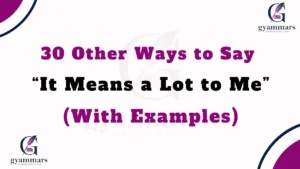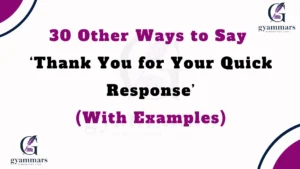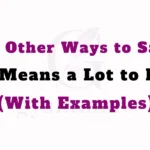When we feel someone is getting a little too involved in our personal affairs, it can be challenging to express ourselves without sounding harsh. It’s important to choose words that convey our thoughts without damaging the relationship.
The right phrases allow us to set boundaries with warmth and care, ensuring our message is both clear and respectful. In this article, we’ll explore 30 different ways to say “Mind Your Own Business,” each accompanied by examples and thoughtful explanations to help you communicate your feelings with empathy.
What Does “Mind Your Own Business” Mean?
“Mind Your Own Business” is often used to tell someone to stop interfering with matters that do not concern them. It’s a direct and sometimes blunt way of establishing boundaries. However, it can come across as harsh or rude if not used carefully, which is why finding gentler alternatives can be very useful.
Is It Professional/Polite to Say “Mind Your Own Business”?
In most situations, saying “Mind Your Own Business” can be considered impolite or unprofessional. It may come across as confrontational or dismissive, making the recipient feel excluded or unwelcome. This can be especially problematic in the workplace, where maintaining good relationships and professional conduct is essential. To maintain respect and professionalism, it’s better to use more polite, diplomatic alternatives.
Pros and Cons of Saying “Mind Your Own Business”
Pros:
- It’s a direct way to establish boundaries.
- It may quickly stop unwanted interference.
Cons:
- It can sound harsh or rude.
- It may damage relationships or come across as disrespectful.
- It may cause unnecessary tension or conflict.
Synonyms For Mind Your Own Business
- Please respect my privacy.
- I’d prefer to keep that to myself.
- That’s not really your concern.
- I’d rather not discuss it.
- Can we talk about something else?
- I appreciate your concern, but I’m fine.
- This is something I’m handling myself.
- I’d rather keep that between me and myself.
- That’s not for discussion right now.
- I’m not comfortable sharing that right now.
- I’d rather not go into details.
- That’s personal.
- I’d appreciate it if we could drop this topic.
- I don’t feel comfortable talking about that.
- I’d prefer not to get into that.
- I appreciate your interest, but it’s private.
- Let’s not get into that right now.
- I’d rather not say.
- That’s something I keep to myself.
- I’d like to keep that private.
- That’s not something I discuss.
- Let’s keep the focus on something else.
- I’m not ready to talk about that.
- Let’s not worry about that.
- I’d rather not get into that.
- I think that’s a private matter.
- That’s a bit personal, don’t you think?
- I’d like to keep that between me and [relevant person].
- Let’s not talk about that right now.
- That’s not something I want to share.
1. “Please Respect My Privacy”
Definition: A polite request for someone to honor your personal boundaries.
Explanation: This phrase gently communicates that the person is overstepping and should give you space.
Scenario Example:
You’re having a personal conversation with a friend, and they begin asking about details you prefer to keep private.
Best Use: When you want to set a respectful boundary.
Tone: Warm, respectful.
Additional Notes: This phrase is non-confrontational and shows care while asserting your privacy.
2. “I’d Prefer to Keep That to Myself”
Definition: A soft way of expressing that something is personal.
Explanation: It suggests that the speaker does not wish to share information, but it’s phrased gently.
Scenario Example:
A colleague asks about your weekend plans, and you prefer not to discuss them.
Best Use: When you want to maintain a level of privacy without sounding dismissive.
Tone: Gentle, considerate.
Additional Notes: A great choice when you’re trying to steer a conversation without creating tension.
3. “That’s Not Really Your Concern”
Definition: A polite way to suggest that someone should focus on their own matters.
Explanation: This phrase sets a boundary but does so in a way that doesn’t come off as entirely rude.
Scenario Example:
Someone asks you about personal matters that aren’t relevant to the conversation.
Best Use: When you need to distance someone from a topic.
Tone: Firm, calm.
Additional Notes: While still direct, it offers a polite nudge to focus on other topics.
4. “I’d Rather Not Discuss It”
Definition: A polite and non-confrontational way to avoid further discussion.
Explanation: This shows that the topic is off-limits without being overly harsh.
Scenario Example:
When a friend pries into a personal topic, you can gently indicate that you’d rather not engage.
Best Use: When you want to shut down a conversation without upsetting anyone.
Tone: Calm, reserved.
Additional Notes: This alternative is perfect for personal situations and can be used in professional settings as well.
5. “Can We Talk About Something Else?”
Definition: A request to change the subject, often used to redirect a conversation away from unwanted personal inquiries.
Explanation: Instead of directly stating the person is meddling, you can steer the conversation in a different direction.
Scenario Example:
Someone keeps asking about your relationship status, and you’d like to change the subject.
Best Use: When you want to avoid conflict but still redirect the conversation.
Tone: Light, friendly.
Additional Notes: This is an excellent way to diffuse tension while guiding the conversation in a new direction.
6. “I Appreciate Your Concern, But I’m Fine”
Definition: A way of acknowledging someone’s interest while gently signaling that you’d prefer to be left alone.
Explanation: It shows gratitude for the person’s concern but also firmly communicates that it’s not necessary to delve deeper.
Scenario Example:
A friend expresses worry over your well-being, but you feel you don’t need to discuss it.
Best Use: When you want to acknowledge someone’s kindness but also maintain your boundaries.
Tone: Appreciative, calm.
Additional Notes: This can help soften the impact of rejecting further inquiries.
7. “This Is Something I’m Handling Myself”
Definition: Emphasizes that you are capable of dealing with the situation on your own.
Explanation: This suggests that you don’t need assistance or input and would prefer to handle things privately.
Scenario Example:
Someone offers unsolicited advice about a personal problem you are already dealing with.
Best Use: When you want to assert your independence.
Tone: Firm, confident.
Additional Notes: This phrase reassures others that you have control over the situation, reducing any potential offense.
8. “I’d Rather Keep That Between Me and Myself”
Definition: A humorous yet clear way of saying you want to keep something personal.
Explanation: It’s a light-hearted way to redirect attention without being confrontational.
Scenario Example:
A colleague asks about a personal project you’re working on, but you want to keep it private.
Best Use: When you need to keep things private in a light and non-serious manner.
Tone: Playful, light.
Additional Notes: This can help alleviate tension in informal settings.
9. “That’s Not for Discussion Right Now”
Definition: A more neutral way of saying that the topic is off-limits for the time being.
Explanation: This lets the person know that it’s not a suitable time to delve into the topic.
Scenario Example:
Someone keeps asking about an issue that is being resolved, and you’re not ready to discuss it.
Best Use: When you want to pause a conversation without rejecting it entirely.
Tone: Neutral, clear.
Additional Notes: This phrase allows for the possibility of discussion at a later time, which can be less off-putting.
10. “I’m Not Comfortable Sharing That Right Now”
Definition: A way to politely communicate discomfort with revealing personal details.
Explanation: This statement allows you to set boundaries without being accusatory.
Scenario Example:
A friend or colleague asks about something deeply personal, and you prefer not to disclose it.
Best Use: When you want to express personal discomfort without sounding defensive.
Tone: Respectful, understanding.
Additional Notes: It’s a gentle, non-confrontational phrase that can be effective in many situations.
11. “I’d Rather Not Go Into Details”
Definition: A gentle way to say you prefer to keep things private.
Explanation: This phrase suggests that you acknowledge the topic but do not wish to elaborate.
Scenario Example:
A coworker asks about your financial situation, and you don’t want to share specifics.
Best Use: When you want to maintain privacy without shutting down the conversation completely.
Tone: Neutral, composed.
Additional Notes: This phrase works well in both casual and professional settings.
12. “That’s Personal”
Definition: A short yet effective way to establish a boundary.
Explanation: It lets the other person know that the topic is private without being overly aggressive.
Scenario Example:
Someone in a group setting asks about your salary.
Best Use: When you need to quickly and firmly shut down a question.
Tone: Direct, but not rude.
Additional Notes: This phrase is most effective when said with a calm and confident tone.
13. “I’d Appreciate It If We Could Drop This Topic”
Definition: A polite request to move on from a discussion.
Explanation: This phrase signals that you do not want to continue the conversation without offending the other person.
Scenario Example:
A family member keeps pressing about your dating life, and you feel uncomfortable.
Best Use: When you want to move away from a topic without causing conflict.
Tone: Polite, firm.
Additional Notes: Best used in situations where the person may not realize they’re overstepping.
14. “I Don’t Feel Comfortable Talking About That”
Definition: A considerate way to express discomfort with a topic.
Explanation: This phrase makes it clear that the subject is off-limits without attacking the other person.
Scenario Example:
A friend asks about your past relationships, but you’d rather not discuss them.
Best Use: When setting boundaries in sensitive discussions.
Tone: Respectful, understanding.
Additional Notes: This phrase is useful in personal conversations and therapy settings.
15. “I’d Prefer Not to Get Into That”
Definition: A way to subtly indicate that a subject is off-limits.
Explanation: This phrase is a diplomatic way to reject an inquiry without being blunt.
Scenario Example:
A nosy coworker asks about your plans after work, and you don’t feel like sharing.
Best Use: When you want to avoid a topic while staying polite.
Tone: Neutral, courteous.
Additional Notes: Works well in social and workplace interactions.
16. “I Appreciate Your Interest, But It’s Private”
Definition: A warm way to acknowledge curiosity while maintaining personal space.
Explanation: It lets the person know you understand their interest but prefer to keep things personal.
Scenario Example:
A friend asks about your family matters, and you’d rather not share details.
Best Use: When you want to be kind while setting boundaries.
Tone: Friendly, considerate.
Additional Notes: This approach helps avoid hurt feelings while keeping things private.
Read More: 30 Other Ways to Say “I Will Keep You Posted” (With Examples)
17. “Let’s Not Get Into That Right Now”
Definition: A casual way to postpone an uncomfortable discussion.
Explanation: This phrase suggests that now is not the best time to talk about a certain topic.
Scenario Example:
During dinner with friends, someone asks about a sensitive issue.
Best Use: When you want to delay a conversation for a more appropriate time.
Tone: Casual, neutral.
Additional Notes: Works well in group settings to avoid awkwardness.
18. “I’d Rather Not Say”
Definition: A short but clear way of keeping things private.
Explanation: It’s a straightforward response that subtly tells the person to stop prying.
Scenario Example:
A stranger asks about your age or salary, and you prefer not to answer.
Best Use: When you need a quick and polite way to avoid answering.
Tone: Neutral, polite.
Additional Notes: Works well in both personal and professional conversations.
19. “That’s Something I Keep to Myself”
Definition: A calm and confident way to assert privacy.
Explanation: It suggests that you have a personal boundary on the topic without making it awkward.
Scenario Example:
A new acquaintance asks about your political or religious beliefs.
Best Use: When keeping personal topics private without being confrontational.
Tone: Respectful, firm.
Additional Notes: This phrase helps maintain a balanced conversation.
20. “I’d Like to Keep That Private”
Definition: A direct yet kind way to avoid oversharing.
Explanation: It sets a boundary while keeping the conversation respectful.
Scenario Example:
A neighbor asks about your relationship problems.
Best Use: When you need to maintain personal space while being polite.
Tone: Warm, understanding.
Additional Notes: This phrase is useful when dealing with persistent inquiries.
21. “That’s Not Something I Discuss”
Definition: A firm but polite statement to shut down a conversation.
Explanation: It signals that the topic is off-limits without escalating the situation.
Scenario Example:
A coworker asks about your finances.
Best Use: When you want to firmly end an inquiry.
Tone: Professional, composed.
Additional Notes: Works well in formal or business settings.
22. “Let’s Keep the Focus on Something Else”
Definition: A way to redirect the conversation to a different topic.
Explanation: This keeps things positive while steering away from a personal subject.
Scenario Example:
At a gathering, someone asks about your personal issues in front of others.
Best Use: When redirecting a conversation in a group setting.
Tone: Light, engaging.
Additional Notes: Helps maintain a friendly atmosphere.
23. “I’m Not Ready to Talk About That”
Definition: A way to indicate that a topic is too sensitive at the moment.
Explanation: This phrase gives you control over when and if you discuss something.
Scenario Example:
A friend asks about a breakup that you’re still processing.
Best Use: When you need space before discussing something difficult.
Tone: Thoughtful, personal.
Additional Notes: This phrase allows for future discussion when you’re comfortable.
24. “Let’s Not Worry About That”
Definition: A casual way to dismiss an inquiry.
Explanation: It subtly tells the other person to move on without making it awkward.
Scenario Example:
Someone asks about your job status, and you don’t want to discuss it.
Best Use: When keeping things lighthearted in a casual setting.
Tone: Friendly, relaxed.
Additional Notes: This is good for informal conversations.
25. “I’d Rather Not Get Into That”
Definition: A straightforward way to decline discussing a topic.
Explanation: This phrase is direct but still maintains a polite tone, making it clear that the subject is off-limits.
Scenario Example:
A colleague asks about why you left your previous job, but you don’t want to explain.
Best Use: When you need to be firm but not rude.
Tone: Professional, composed.
Additional Notes: Works well in formal and informal settings.
26. “I Think That’s a Private Matter”
Definition: A neutral way to suggest that a topic isn’t meant for public discussion.
Explanation: This makes it clear that the subject is personal without sounding too defensive.
Scenario Example:
A friend asks about your family finances, and you prefer not to share details.
Best Use: When handling sensitive topics with tact.
Tone: Professional, polite.
Additional Notes: Best used when discussing confidential matters.
27. “That’s a Bit Personal, Don’t You Think?”
Definition: A lighthearted way to point out that someone is asking something too private.
Explanation: This phrase makes the person aware that they may be overstepping without being too harsh.
Scenario Example:
A coworker asks how much you spent on your new car.
Best Use: When you want to highlight an overstep without offending.
Tone: Playful, casual.
Additional Notes: Works well with people you have a friendly relationship with.
28. “I’d Like to Keep That Between Me and [Relevant Person]”
Definition: A way to indicate that certain information is meant to be shared with specific people only.
Explanation: This lets the other person know that the matter is private but not necessarily secret.
Scenario Example:
A family member asks about a personal issue that you’re only discussing with your partner.
Best Use: When you want to make it clear that a discussion is not for everyone.
Tone: Calm, reassuring.
Additional Notes: Helps prevent further questioning without sounding defensive.
29. “Let’s Not Talk About That Right Now”
Definition: A phrase to postpone or dismiss a topic.
Explanation: This lets the other person know that now is not the right time for this discussion.
Scenario Example:
A friend asks about your health condition, but you don’t want to talk about it in public.
Best Use: When you want to defer a conversation without shutting it down completely.
Tone: Neutral, composed.
Additional Notes: Useful in situations where you might be open to discussing the topic later.
30. “That’s Not Something I Want to Share”
Definition: A clear, respectful way to express your boundaries.
Explanation: This phrase makes it clear that you are choosing to keep something private.
Scenario Example:
A new acquaintance asks about your religious beliefs, but you prefer not to discuss them.
Best Use: When you need to set a firm boundary while being respectful.
Tone: Honest, direct.
Additional Notes: Helps avoid unwanted follow-up questions.
Conclusion
Setting boundaries is essential in maintaining respectful and healthy interactions. While “Mind Your Own Business” may be the most direct way to ask someone to back off, it’s not always the best choice. The alternatives in this list allow you to express your need for privacy in a way that maintains positive relationships. Whether you’re in a professional setting, a personal conversation, or a casual chat, choosing the right words can make all the difference in how your message is received.
1. Why is it important to choose alternative phrases instead of just saying “Mind Your Own Business?”
Choosing alternatives to “Mind Your Own Business” helps convey your message in a way that is respectful, clear, and non-confrontational. It allows you to set boundaries without damaging relationships, fostering a more understanding and empathetic atmosphere. By selecting more thoughtful phrases, you can maintain your privacy while also showing consideration for others’ feelings.
2. Can these phrases be used in professional settings?
Yes, many of the alternatives listed in the article are professional and polite enough for workplace situations. For example, phrases like “I’d prefer to keep that to myself” or “I’m not ready to talk about that” are appropriate for communicating boundaries without sounding rude or dismissive. Choosing your words carefully helps maintain professionalism while asserting privacy.
3. What if someone insists on prying even after I’ve set a boundary?
If someone continues to pry after you’ve set a boundary, it may be helpful to be firmer but still polite. You can repeat your boundary with a calm tone, such as, “I’ve mentioned that I prefer to keep this private.” If the person still insists, it’s okay to be more direct and say something like, “I’ve asked for privacy on this topic, and I’d appreciate it if we could move on.”
4. Are there any alternatives for saying “Mind Your Own Business” in a more playful or light-hearted manner?
Yes! Some of the alternatives can be used in a playful context without sounding too harsh. For instance, “That’s a bit personal, don’t you think?” or “Let’s keep the focus on something else” can be used in casual conversations to diffuse any tension while still setting boundaries in a lighthearted way.
5. How can I avoid sounding rude when using these phrases?
Tone is key! While the phrases are designed to be polite and considerate, it’s important to deliver them with warmth. Instead of sounding defensive or frustrated, try saying these phrases with a calm and respectful tone. Smiling while saying them can also soften the impact and help the other person understand that you’re just setting a boundary, not rejecting them.

“Emma Rose at Grammar Synonyms is your go-to expert for everything related to language and expression. Whether you’re refining your grammar, searching for the perfect synonym, or looking for creative ways to improve your writing, Emma Rose provides the tools and inspiration you need. With a wide range of resources designed to elevate your communication, Grammar Synonyms helps you find just the right words to make every sentence shine.












